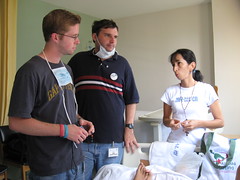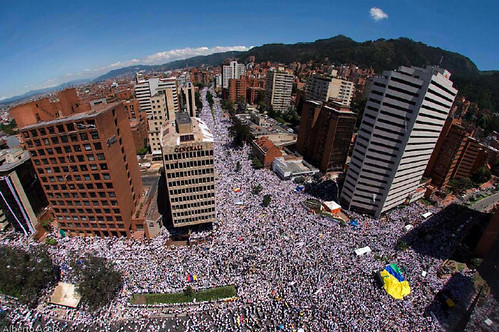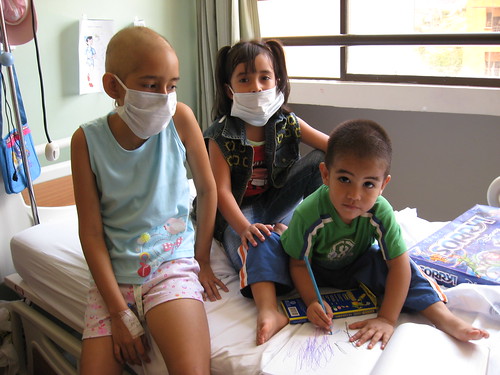I know some of you are probably sick of reading all the information I've been forcing on you about Colombia, but please keep reading. I don't often take advantage of people who read my blog by making direct appeals, but this is the most important thing I've ever been involved in.
I know, a bold statement, but I mean it. Last week, I told you about about how I had about a citizen's initiative to organize a peaceful, nonviolent march to the Colombian jungle and demand the rescue of the kidnapped hostages there. Jorge Altuzarra explained, in his interview with Caracol Radio in Colombia, that the initiative began with Facebook groups after a series of hugely successful peace marches in Colombia and around the world. I was so inspired by this grassroots initiative that I posted a message on the Facebook group (which now has thousands of members) and offered to help.
Several hours later, I got an email from Jorge, whom I had heard on the radio, saying that they would be delighted to have my help since they will need to get international news coverage and the support and accompaniment of many humanitarian organizations and individual volunteers. I've now been given an email address, which is information@rescatecivil.org and working with a team of people in Colombia, Europe, Australia, Canada, and another Colombian representative in Miami, to get the word out and translate documents to English.
I have just finished translating the open letter from the group that explains the overall goals and mission. There are other documents in progress directed at the FARC, the United Nations, and various humanitarian organizations around the world. I need letters from organizations in the United States expressing support for the non-violent march and media coverage from U.S. or international news media. After all, Colombians are doing their part to rescue victims of kidnapping, and the French have been working for years to free the French-Colombian, Ingrid Betancourt, so let's do our part for our three fellow American citizens that are now on their fifth year after being kidnapped by the FARC.
CIVILIAN RESCUE:I know, a bold statement, but I mean it. Last week, I told you about about how I had about a citizen's initiative to organize a peaceful, nonviolent march to the Colombian jungle and demand the rescue of the kidnapped hostages there. Jorge Altuzarra explained, in his interview with Caracol Radio in Colombia, that the initiative began with Facebook groups after a series of hugely successful peace marches in Colombia and around the world. I was so inspired by this grassroots initiative that I posted a message on the Facebook group (which now has thousands of members) and offered to help.
Several hours later, I got an email from Jorge, whom I had heard on the radio, saying that they would be delighted to have my help since they will need to get international news coverage and the support and accompaniment of many humanitarian organizations and individual volunteers. I've now been given an email address, which is information@rescatecivil.org and working with a team of people in Colombia, Europe, Australia, Canada, and another Colombian representative in Miami, to get the word out and translate documents to English.
I have just finished translating the open letter from the group that explains the overall goals and mission. There are other documents in progress directed at the FARC, the United Nations, and various humanitarian organizations around the world. I need letters from organizations in the United States expressing support for the non-violent march and media coverage from U.S. or international news media. After all, Colombians are doing their part to rescue victims of kidnapping, and the French have been working for years to free the French-Colombian, Ingrid Betancourt, so let's do our part for our three fellow American citizens that are now on their fifth year after being kidnapped by the FARC.
THE NEXT STEP IN THE SEARCH FOR PEACE
The idea of a civilian-lead rescue of the more than 700 hostages held by the Armed Revolutionary Forces of Colombia (FARC) is not new, nor does it belong to any one individual or group. For over sixty years, the Colombian people have been the victim of a vicious and violent power struggle between the National government, and Left wing insurgency groups, and right wing paramilitaries. While violence has diminished in much of Colombia, and there is much reason for optimism, government negotiations with the FARC for the release of hostages have frequently failed. Many of those kidnapped by the FARC, which include several foreigners, have spent the last ten years held captive in the Colombian jungle.
Several recent events have renewed hope and solidarity among Colombians, leading to a uniquely civilian, non-violent, and non-political uprising. On June 17th, 2007, Professor Gustavo Moncayo, commonly known as the “peace walker”, set out on a walk that took him 1,186 kilometers to the capital city of Bogotá, in an effort to promote an agreement for the release of his son, Pablo Emilio, who has kidnapped by the FARC in 1997. On July 5th of the same year, Colombians responded with nationwide demonstrations against kidnapping, and February 4th of 2008, peace marches around the world were organized to speak out against the FARC. More than 5 million people participated in Colombia alone, and simultaneous marches were held in more than 100 cities around the world. For many, it seemed the next logical step should be a peaceful march to the jungle, where most of the hostages are held.
Some prominent individuals, like ex-mayors of Bogotá, Anthanas Mockus and Lucho Garzón, announced the idea in public. Furthermore, the Association of Disabled Policemen (FRAPON), who marched more than 500 kilometers in their wheel chairs to demand the liberation of FARC hostages, proposed the idea after completing their journey in Bogotá.
Nevertheless, the civilian rescue initiative has its origins many years back, inspired by non-violent movements lead by Gandhi and many others around the world, as well as more recent examples of non-violent civil resistance, such as the groups of Colombian indigenous groups who confronted the FARC at the edge of their communities in order to prevent their lands from being destroyed. Indigenous groups can also be credited with the first example of successful, civilian-lead hostage rescue, when, in August of 2004, the indigenous guard, composed of more than 500 people, but armed only with wooden staves, mobilized and entered the jungle to rescue two indigenous ex-mayors held captive by the FARC.
After the February 4th marches against the FARC, many Colombians proposed a civilian rescue initiative in more than 10 groups in the social networking site, Facebook; all with the same idea: to go to the jungle and rescue the people held hostage there by FARC guerrillas. However, only one group turned the idea into a concrete initiative, and, with a defined plan of action, began to unite hundreds of people willing to commit themselves to a clear and viable proposal - in short, to march to San José del Guaviare, the epicenter of the recent hostage liberations, and bring together at least 1,000 volunteers, at least 18 years of age, in good physical condition, and available for at least two weeks, who are willing to march to the jungle.
Under the premise of “strength in unity”, seven groups accepted the invitation, giving birth to the Civilian Rescue Group “LET’S GO GET THEM”, which, under the humanitarian principles of respect for liberty, non-violence, and voluntary disarmament, was made public and presented as an entirely peaceful and humanitarian proposal, respectful of the Rule of Law, and without any political affiliation or bias.
This initiative, which is now under way, is divided in three phases that allow for its execution and success. The first is an appeal to, and examination of, public opinion, looking to establish the group of marchers, minimum security guarantees, and the support of the national and international community.
Being aware of the inherent risks of the proposed zone, which is in the heart of FARC territory, and with such cases as those of the ex-governor Guillermo Gaviria, who was kidnapped during a peace march in 2002, and Ingrid Betancourt, the French-Colombian presidential candidate who was kidnapped during her campaign the same year, the Civilian Rescue Group has adopted serious physical/personal safety measures as a priority of utmost importance for the undertaking of the march. Thus, it is required that the participants be of legal age, in good physical shape, and available for at least two weeks. Along this same line of thought, we are securing the attendance and accompaniment of national and international human rights organizations, as well as some minimum security guarantees that should be offered by the Armed Forces, granted under Article 2 of our National Constitution.
Additionally, we are presenting a formal petition to the National Government for a humanitarian landmine removal squad to go to the zone with us to remove landmines and other explosive devices.
The second phase comprises much more than just a symbolic march between Villavicencio and San José del Guaviare. It is a humanitarian call to the members of the FARC that are holding people captive, to demobilize and unilaterally hand over the hostages to the Colombian people. Furthermore, the Colombian, whose well-being is the supposed objective of the FARC’s armed struggle, invite and demand the members of the FARC, to free, not only their hostages, but also to free themselves and return to society.
This is the essence of our humanitarian initiative, advocating dialogue and reconciliation as a determining mechanism in achieving the peace that we all long for, but demanding an end to kidnapping as a means of manipulating the population and extorting funds. It is now when we most need Colombian people, and all people, to unite as one voice, in one call for peace that will be heard in the greatest depths of the Colombian jungle.
The final phase of our proposal calls for the installation of a center of operations in San José del Guaviare, so that from there, various expeditions may go out into the jungle with the goal of finding FARC camps where the kidnapped hostages are held. However, this phase will only be carried out once the path has been cleared by anti-explosive experts who can guarantee our safety, in this regard. If we are unable to meet this minimum security condition, we will remain waiting, as a group, for seven more days, inviting the FARC to demobilize and release those hostages facing the greatest risks to their health.
Independently of the result of this humanitarian operation, the group of marchers will return to their places of origin on the 27th of June in order to multiply the humanitarian initiative in each part of the country where victims of kidnapping are held. The Civilian Rescue Group will not rest until those unjustly deprived of their freedom have been released alive, and Colombia is free of the tragic and barbaric practice of kidnapping.
CIVILIAN RESCUE GROUP “LET’S GO GET THEM”
Onward for peace…






 Yesterday, I spent the whole day getting a new Flickr account and blog set up for the participants in the "Lives Worth Sharing" photography project, and today, Fundación Esperanza Viva (Living Hope Foundation) in Bucaramanga, Colombia, posted their first photographs taken by child cancer patients with the camera they were selected to receive. This photograph, titled "Saturday Afternoon in Bed" was taken by a young patient on a Saturday afternoon.... I was struck by the contrast between the serious reality of terminal illness and the apparent carefree coloring we hope for and expect during childhood years. You can see more pictures from the project at
Yesterday, I spent the whole day getting a new Flickr account and blog set up for the participants in the "Lives Worth Sharing" photography project, and today, Fundación Esperanza Viva (Living Hope Foundation) in Bucaramanga, Colombia, posted their first photographs taken by child cancer patients with the camera they were selected to receive. This photograph, titled "Saturday Afternoon in Bed" was taken by a young patient on a Saturday afternoon.... I was struck by the contrast between the serious reality of terminal illness and the apparent carefree coloring we hope for and expect during childhood years. You can see more pictures from the project at 














